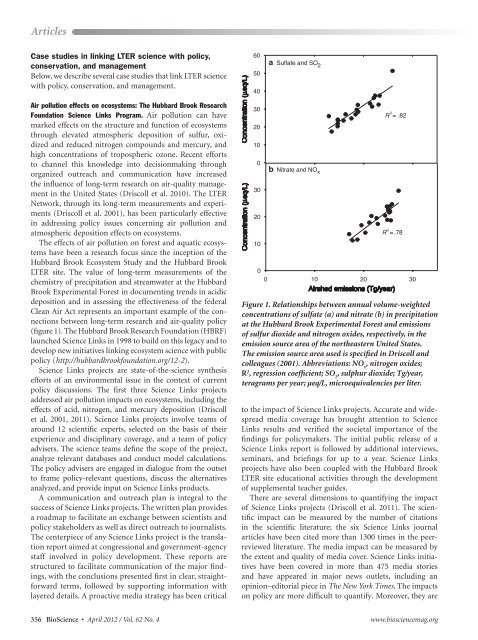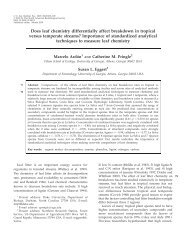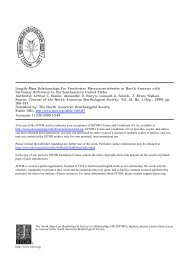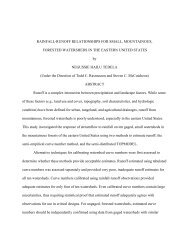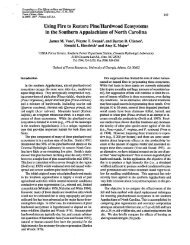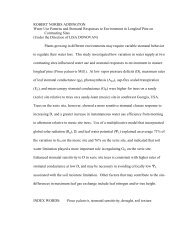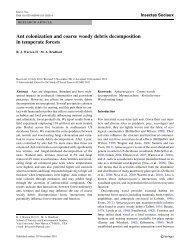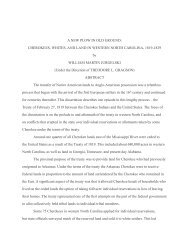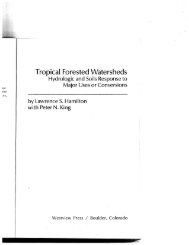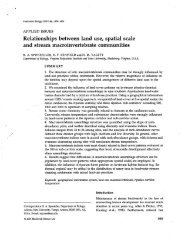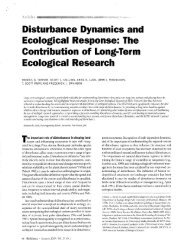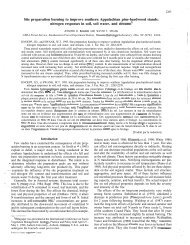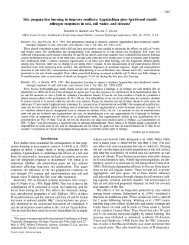biology join - Coweeta LTER - University of Georgia
biology join - Coweeta LTER - University of Georgia
biology join - Coweeta LTER - University of Georgia
You also want an ePaper? Increase the reach of your titles
YUMPU automatically turns print PDFs into web optimized ePapers that Google loves.
Articles<br />
Case studies in linking <strong>LTER</strong> science with policy,<br />
conservation, and management<br />
Below, we describe several case studies that link <strong>LTER</strong> science<br />
with policy, conservation, and management.<br />
Air pollution effects on ecosystems: The Hubbard Brook Research<br />
Foundation Science Links Program. Air pollution can have<br />
marked effects on the structure and function <strong>of</strong> ecosystems<br />
through elevated atmospheric deposition <strong>of</strong> sulfur, oxidized<br />
and reduced nitrogen compounds and mercury, and<br />
high concentrations <strong>of</strong> tropospheric ozone. Recent efforts<br />
to channel this knowledge into decisionmaking through<br />
organized outreach and communication have increased<br />
the influence <strong>of</strong> long-term research on air-quality management<br />
in the United States (Driscoll et al. 2010). The <strong>LTER</strong><br />
Network, through its long-term measurements and experiments<br />
(Driscoll et al. 2001), has been particularly effective<br />
in addressing policy issues concerning air pollution and<br />
atmospheric deposition effects on ecosystems.<br />
The effects <strong>of</strong> air pollution on forest and aquatic ecosystems<br />
have been a research focus since the inception <strong>of</strong> the<br />
Hubbard Brook Ecosystem Study and the Hubbard Brook<br />
<strong>LTER</strong> site. The value <strong>of</strong> long-term measurements <strong>of</strong> the<br />
chemistry <strong>of</strong> precipitation and streamwater at the Hubbard<br />
Brook Experimental Forest in documenting trends in acidic<br />
deposition and in assessing the effectiveness <strong>of</strong> the federal<br />
Clean Air Act represents an important example <strong>of</strong> the connections<br />
between long-term research and air-quality policy<br />
(figure 1). The Hubbard Brook Research Foundation (HBRF)<br />
launched Science Links in 1998 to build on this legacy and to<br />
develop new initiatives linking ecosystem science with public<br />
policy (http://hubbardbrookfoundation.org/12-2).<br />
Science Links projects are state-<strong>of</strong>-the-science synthesis<br />
efforts <strong>of</strong> an environmental issue in the context <strong>of</strong> current<br />
policy discussions. The first three Science Links projects<br />
addressed air pollution impacts on ecosystems, including the<br />
effects <strong>of</strong> acid, nitrogen, and mercury deposition (Driscoll<br />
et al. 2001, 2011). Science Links projects involve teams <strong>of</strong><br />
around 12 scientific experts, selected on the basis <strong>of</strong> their<br />
experience and disciplinary coverage, and a team <strong>of</strong> policy<br />
advisers. The science teams define the scope <strong>of</strong> the project,<br />
analyze relevant databases and conduct model calculations.<br />
The policy advisers are engaged in dialogue from the outset<br />
to frame policy-relevant questions, discuss the alternatives<br />
analyzed, and provide input on Science Links products.<br />
A communication and outreach plan is integral to the<br />
success <strong>of</strong> Science Links projects. The written plan provides<br />
a roadmap to facilitate an exchange between scientists and<br />
policy stakeholders as well as direct outreach to journalists.<br />
The centerpiece <strong>of</strong> any Science Links project is the translation<br />
report aimed at congressional and government-agency<br />
staff involved in policy development. These reports are<br />
structured to facilitate communication <strong>of</strong> the major findings,<br />
with the conclusions presented first in clear, straightforward<br />
terms, followed by supporting information with<br />
layered details. A proactive media strategy has been critical<br />
to the impact <strong>of</strong> Science Links projects. Accurate and widespread<br />
media coverage has brought attention to Science<br />
Links results and verified the societal importance <strong>of</strong> the<br />
findings for policymakers. The initial public release <strong>of</strong> a<br />
Science Links report is followed by additional interviews,<br />
seminars, and briefings for up to a year. Science Links<br />
projects have also been coupled with the Hubbard Brook<br />
<strong>LTER</strong> site educational activities through the development<br />
<strong>of</strong> supplemental teacher guides.<br />
There are several dimensions to quantifying the impact<br />
<strong>of</strong> Science Links projects (Driscoll et al. 2011). The scientific<br />
impact can be measured by the number <strong>of</strong> citations<br />
in the scientific literature; the six Science Links journal<br />
articles have been cited more than 1300 times in the peerreviewed<br />
literature. The media impact can be measured by<br />
the extent and quality <strong>of</strong> media cover. Science Links initiatives<br />
have been covered in more than 475 media stories<br />
and have appeared in major news outlets, including an<br />
opinion–editorial piece in The New York Times. The impacts<br />
on policy are more difficult to quantify. Moreover, they are<br />
356 BioScience • April 2012 / Vol. 62 No. 4 www.biosciencemag.org<br />
a<br />
b<br />
Figure 1. Relationships between annual volume-weighted<br />
concentrations <strong>of</strong> sulfate (a) and nitrate (b) in precipitation<br />
at the Hubbard Brook Experimental Forest and emissions<br />
<strong>of</strong> sulfur dioxide and nitrogen oxides, respectively, in the<br />
emission source area <strong>of</strong> the northeastern United States.<br />
The emission source area used is specified in Driscoll and<br />
colleagues (2001). Abbreviations: NO x , nitrogen oxides;<br />
R 2 , regression coefficient; SO 2 , sulphur dioxide; Tg/year,<br />
teragrams per year; µeq/L, microequivalencies per liter.


